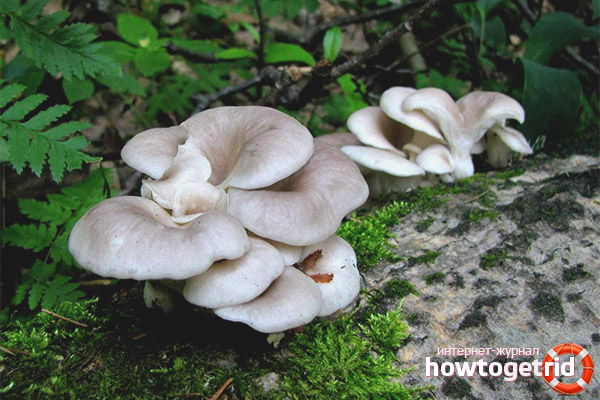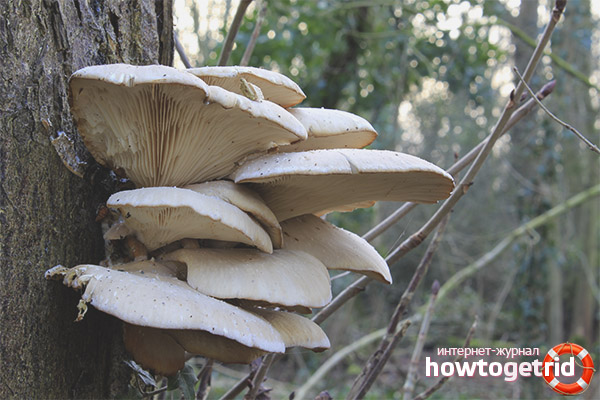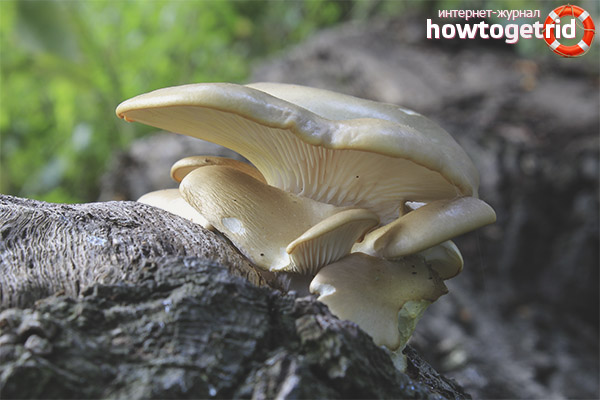The content of the article
Oyster mushroom, or in Latin pleurotus cornucopiae, belongs to the oyster mushroom family. Oyster mushroom got such an unusual name due to its horn-shaped form, which resembles a curved horn of a shepherd. The fungus is considered edible and cultivated for a long period.
Currently, these mushrooms are especially popular among mushroom pickers. In pre-revolutionary times, this mushroom was known in Russia under the unusual name of ishiven. In Ukraine, oyster mushroom was called “gliva”, and in the Caucasus, “ka’char”.
Appearance and characteristic of oyster mushroom
Oyster mushroom differs from other congeners in its funnel-shaped and slightly elongated cap. Sometimes the roundness of the cap can be linguistic or leaf-shaped. At the same time, the edges of the hat are slightly curved upward, and the surface itself has a smooth structure. In old mushrooms, curvature is almost invisible. The average size of the mushroom cap can range from 3 to 9 centimeters in diameter. Sometimes mushroom pickers also meet larger mushrooms, in which the hats reach 12 cm.
The color of the fungus primarily indicates the age of oyster mushroom, as well as where it grows and in what conditions. Young fungi differ from mature relatives in the white or grayish color of the skin. But more mature oyster mushrooms may have a brownish color. At the place where the horn is formed, the mushroom peel may have a lilac color.
The oyster mushroom leg can grow from 2 to 6 cm in length, while the width can go up to 1.5 cm. Sometimes it can stretch up to 8 cm in length. The oyster mushroom leg grows in the center, sometimes located on the side, sometimes slightly narrowed to the base. The oyster mushroom leg is white, sometimes it has a characteristic sand color. If we compare oyster mushroom with oyster mushrooms with other representatives of the oyster mushroom family, then the first leg is most clearly expressed.
The inside of the oyster mushroom has an elastic white flesh, with a thin core. When the mushroom grows up, the flesh becomes hard to the touch. The taste and smell of oyster mushroom is not very pronounced, but its flesh has a powdery flavor.
Edibility of oyster mushrooms
Horn-shaped oyster mushroom is considered an edible specimen among other representatives of the mushroom kingdom. Mushroom pickers relate it to the 3-4th category according to the classification of edibility.
Lovers of mushrooms are great for the taste of oyster mushrooms. It can be stewed, fried, marinated and even salted - nothing will spoil its fragrant, bready flavor. Oyster mushrooms are often dried and then powder is made from it. In frayed form, it has a characteristic rye aroma, which makes the taste special. The taste of oyster mushrooms goes well with meat and game.
Note! Before serving, the oyster mushroom should be subjected to prolonged heat treatment to destroy the substance chitin contained in the mushroom. This is mostly true for mature mushrooms. But younger oyster mushrooms boil just 20 minutes in water.
Oyster mushrooms are highly popular in gastronomy. Today, mushrooms are artificially cultivated on mushroom plantations. They like and grow oyster mushroom not only in Russia, but also in other parts of the world. In addition, it is widely used for medical purposes. That is why oyster mushroom is an excellent specimen for mushroom hunting in the forest.
Fortunately, oyster mushrooms have absolutely no poisonous relatives, so it will be much easier for inexperienced mushroom pickers to search for her.Lovers of mushrooms may come across unless on their close counterparts - oyster mushroom or oyster mushroom autumn, however, these two instances differ from the horn-shaped darker brown hat.
Where and when does the oyster mushroom grow

Despite the fact that carob-shaped oyster mushrooms are widely cultivated and artificially grown in specially equipped places, mushroom pickers can also meet them in the wild. It is better to collect oyster mushrooms from late spring to mid-autumn. Usually mushroom pickers go in search of oyster mushrooms as early as May.
These mushrooms grow in the steppes and in the forest-steppe zone in Ukraine and Russia, and oyster mushroom is also widespread in the Caucasus, China and Japan. Mostly this specimen loves to grow in deciduous forests, often settles on dead tree trunks and on stumps. Mushroom pickers can easily stumble on oyster mushrooms on the trunk of an oak, maple or elm. These mushrooms love to settle in impassable places: in thickets and among densely growing trees.
Oyster mushroom grows quite abundantly, usually settles in forest-steppe areas with a large group of relatives from 7 to 15 mushrooms per place. If a mushroom picker manages to stumble upon one such mushroom family, then you can immediately collect up to one kilogram of mushrooms in a basket at a time. However, the search for oyster mushrooms is often hampered by the fact that these mushrooms prefer to settle in hard-to-reach places: among shrubs and deadwood.
Video: oyster mushroom (Pleurotus cornucopiae)











Submit